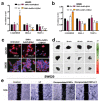Diatom-Based Nanomedicine for Colorectal Cancer Treatment: New Approaches for Old Challenges
- PMID: 37233460
- PMCID: PMC10222510
- DOI: 10.3390/md21050266
Diatom-Based Nanomedicine for Colorectal Cancer Treatment: New Approaches for Old Challenges
Abstract
Colorectal cancer is among the most prevalent and lethal cancers globally. To address this emergency, countries have developed diffuse screening programs and innovative surgical techniques with a consequent decrease in mortality rates in non-metastatic patients. However, five years after diagnosis, metastatic CRC is still characterized by less than 20% survival. Most patients with metastatic CRC cannot be surgically treated. For them, the only option is treatment with conventional chemotherapies, which cause harmful side effects in normal tissues. In this context, nanomedicine can help traditional medicine overcome its limits. Diatomite nanoparticles (DNPs) are innovative nano-based drug delivery systems derived from the powder of diatom shells. Diatomite is a porous biosilica largely found in many areas of the world and approved by the Food and Drug Administration (FDA) for pharmaceutical and animal feed formulations. Diatomite nanoparticles with a size between 300 and 400 nm were shown to be biocompatible nanocarriers capable of delivering chemotherapeutic agents against specific targets while reducing off-target effects. This review discusses the treatment of colorectal cancer with conventional methods, highlighting the drawbacks of standard medicine and exploring innovative options based on the use of diatomite-based drug delivery systems. Three targeted treatments are considered: anti-angiogenetic drugs, antimetastatic drugs, and immune checkpoint inhibitors.
Keywords: biosilica; chemotherapy; colorectal cancer (CRC); diatoms; nanomedicine; nanotechnology; neoplasm metastasis.
Conflict of interest statement
The authors declare no conflict of interest.
Figures






References
-
- Redmond E., Lally C., Cahill P. Chapter 3—Common Pathways in Cancer, Tumor Angiogenesis and Vascular Disease. In: Gottlieb R.A., Mehta P.K., editors. Cardio-Oncology. Academic Press; Boston, MA, USA: 2017. pp. 35–53. - DOI
-
- Gaffey M.J., Mills S.E., Lack E.E. Neuroendocrine Carcinoma of the Colon and Rectum A Clinicopathologic, Ultrastructural, and Immunohistochemical Study of 24 Cases. [(accessed on 21 April 2023)];Am. J. Surg. Pathol. 1990 14:1010–1023. doi: 10.1097/00000478-199011000-00003. Available online: https://journals.lww.com/ajsp/Fulltext/1990/11000/Neuroendocrine_Carcino.... - DOI - PubMed
Publication types
MeSH terms
Substances
LinkOut - more resources
Full Text Sources
Medical

